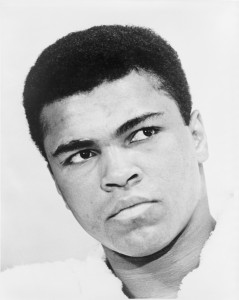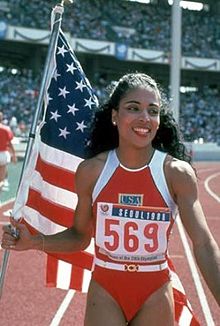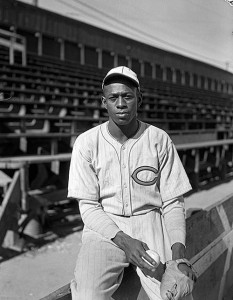Black History, Sports

Jersey Joe Walcott
1914 – 1994. The oldest heavyweight (37) to ever win the championship; lost four championship bouts before knocking out Ezzard Charles in the seventh round in 1951; lost the title the following year, losing to Rocky Marciano; won 50 bouts, 30 by knockout, lost 17 and fought one draw as a professional; later became sheriff of Camden County, NJ.
Jersey Joe Walcott was the picture of perseverance. He won the heavyweight title in his fifth try, accomplishing the feat at the age of 37. He held the record for oldest heavyweight champion until 45-year-old George Foreman won the crown in 1994.
Born Arnold Cream in Merchantville, New Jersey, Walcott took the name of his boxing idol, Joe Walcott, the welterweight champion from Barbados. He turned pro in 1930 at the age of 16 and embarked on a slow, but steady, rise to the top. (more…)
Black History, Civil Rights, Sports

Muhammad Ali
Muhammed Ali was born Cassius Clay in Louisville, Kentucky. From 1956-60, Clay fought as an amateur (winning 100 of 108 matches) before becoming the light-heavyweight gold medalist in the 1960 Olympics. Financed by a group of Louisville businessmen, he turned professional and by 1963 had won his first 19 fights. In 1964 he won the world heavyweight championship with a stunning defeat of Sonny Liston. Immediately afterwards, Clay announced that he was a Black Muslim and had changed his name to Muhammad Ali.
In 1967, after defending the championship nine times within two years, Ali was stripped of his title for refusing induction into the U.S. Army based on religious grounds. His action earned him both respect and anger from different quarters, but he did not box for three and one-half years until, in 1971, he lost to Joe Frazier.
A few months later, the U.S. Supreme Court affirmed his right to object to military service on religious grounds and Ali regained the title in 1974 by knocking out George Foreman in Zaire, Africa. Ali defended his title 10 times before losing to Leon Spinks in 1978. When he defeated Spinks later that same year, he became the first boxer ever to regain the championship twice. (more…)
Black History, Sports
. During the Jim Crow era, African American college teams were barred from the National Collegiate Athletic Association (NCAA) and the National Invitational Tournament (NIT). But a brave few found ways around these restrictions. A secret game held in 1944 between a white team from Duke University and a black team from North Carolina Central University was one of the first integrated sports events in the South.
During the Jim Crow era, African American college teams were barred from the National Collegiate Athletic Association (NCAA) and the National Invitational Tournament (NIT). But a brave few found ways around these restrictions. A secret game held in 1944 between a white team from Duke University and a black team from North Carolina Central University was one of the first integrated sports events in the South.
In early 1944, black and white students from North Carolina Central University and Duke University met at the Durham YMCA for clandestine prayer meetings. A friendly challenge led to a basketball game between the NCCU varsity team and the team from Duke’s medical school to determine the best team in Durham. (more…)
Black History, Sports
At the 1988 Olympic trials, while outfitted in a one-legged purple track suit and sporting four inch fingernails, she set a world record in the 100 meters, running it at 10.49 seconds, knocking more than a quarter of a second off her best-ever time despite not even being one of the country’s best in the event a year earlier.

Flo Jo at the Seoul Olympic Games in 1988
Florence Delorez Griffith grew up in a housing project in the Watts neighborhood of Los Angeles as the seventh of eleven children. From an early age, Griffith enjoyed competition and sought attention. She held handstand competitions, rode around on a unicycle, designed unique clothes for her Barbie doll, wore strange hairdos and owned a trained pet rat. And she was fast. Florence’s father often told a story about taking the kids to the nearby Mojave Desert when she was five and challenging them to chase jackrabbits. Florence caught one. “Jackrabbit” became her nickname.
By age 7, she was competing in track. In high school, she set records in sprints and the long jump. Following graduation, she competed at Cal State Northridge under the legendary sprint coach Bob Kersee and helped them win the national championship in 1978. (more…)

Black History, Firsts, Sports
Born on Dec. 13, 1923, in Camden, S.C., Doby grew up in New Jersey. He didn’t start out in life longing for a career in professional baseball. He once said that he grew up wanting to teach and coach in high school.
But in 1942, a Negro League umpire recommended to the owner of the Newark Eagles that Doby, still in high school at the time, get a tryout. “They gave me a tryout, and I made the team,” Doby said. “That’s how I got involved in Negro League Baseball.”
Doby proved he was star material early in his Negro League days. He was an All-Star second baseman whose baseball credentials might have been better than Robinson’s. (more…)
Black History, Sports

Leroy ‘Satchel’ Paige
Regarded as the nearest thing to a legend that ever came out of the Negro Leagues, this tall, lanky right-hander parlayed a pea-sized fastball, nimble wit, and a colorful personality into a household name that is recognized by people who know little about baseball itself and even less about the players who performed in the Jim Crow era of organized baseball. His name has become synonymous with the barnstorming exhibitions played between traveling black teams and their white counterparts.
A mixture of fact and embellishment, Satchel’s stories are legion and form a rich array of often-repeated folklore. On many occasions he would pull in the outfielders to sit behind the mound while he proceeded to strike out the side with the tying run on base. Once he intentionally walked Howard Easterling and Buck Leonard to load the bases so he could pitch to Josh Gibson, the most dangerous hitter in black baseball, and then struck him out. He was advertised as guaranteed to strike out the first nine batters he faced in exhibition games, and he almost invariably fulfilled his billing.
Satchel frequently warmed up by throwing twenty straight pitches across a chewing gum wrapper that was being used for home plate. His “small” fastball was described by some hitters as looking like a half dollar. Others said that he wound up with a pumpkin and threw a pea. But Biz Mackey had the best story about how small his fastball looked. He said that once Satchel threw the ball so hard that the ball disappeared before it reached the catcher’s mitt. The stories are endless. But the facts are also impressive. (more…)





